The Spillover Effect of Geotagged Tweets as a Measure of Ambient Population for Theft Crime
Abstract
1. Introduction
2. Study Area and Data
3. Method
4. Results
5. Discussion and Conclusions
Author Contributions
Funding
Acknowledgments
Conflicts of Interest
References
- Demombynes, G.; Özler, B. Crime and local inequality in South Africa. J. Dev. Econ. 2005, 76, 265–292. [Google Scholar] [CrossRef]
- Hirschfield, A.; Brown, P.; Todd, P. GIS and the analysis of spatially-referenced crime data: Experiences in Merseyside, UK. Int. J. Geogr. Inf. Syst. 1995, 9, 191–210. [Google Scholar] [CrossRef]
- Morenoff, J.D.; Sampson, R.J. Violent crime and the spatial dynamics of neighborhood transition: Chicago, 1970–1990. Soc. Forces 1997, 76, 31–64. [Google Scholar] [CrossRef]
- Kennedy, L.W.; Forde, D.R. Routine activities and crime: An analysis of victimization in Canada. Criminology 1990, 28, 137–152. [Google Scholar] [CrossRef]
- Du, F.; Liu, L.; Jiang, C.; Long, D.; Lan, M. Discerning the Effects of Rural to Urban Migrants on Burglaries in ZG City with Structural Equation Modeling. Sustainability 2019, 11, 561. [Google Scholar] [CrossRef]
- Song, G.; Liu, L.; Bernasco, W.; Xiao, L.; Zhou, S.; Liao, W. Testing indicators of risk populations for theft from the person across space and time: The significance of mobility and outdoor activity. Ann. Am. Assoc. Geogr. 2018, 108, 1370–1388. [Google Scholar] [CrossRef]
- McPherson, T.N.; Brown, M.J. Estimating Daytime and Nighttime Population Distributions in Us Cities for Emergency Response Activities; Los Alamos National Laboratory (LANL): Los Alamos, NM, USA, 2003.
- Malleson, N.; Andresen, M.A. Exploring the impact of ambient population measures on London crime hotspots. J. Crim. Justice 2016, 46, 52–63. [Google Scholar] [CrossRef]
- Song, G.; Bernasco, W.; Liu, L.; Xiao, L.; Zhou, S.; Liao, W. Crime Feeds on Legal Activities: Daily Mobility Flows Help to Explain Thieves’ Target Location Choices. J. Quant. Criminol. 2019, 14, 1–24. [Google Scholar] [CrossRef]
- Boggs, S.L. Urban crime patterns. Am. Sociol. Rev. 1965, 30, 899–908. [Google Scholar] [CrossRef]
- Andresen, M.A. Crime measures and the spatial analysis of criminal activity. Br. J. Criminol. 2005, 46, 258–285. [Google Scholar] [CrossRef]
- Andresen, M.A. A spatial analysis of crime in Vancouver, British Columbia: A synthesis of social disorganization and routine activity theory. Can. Geogr. 2006, 50, 487–502. [Google Scholar] [CrossRef]
- Andresen, M.A.; Jenion, G.W. Ambient populations and the calculation of crime rates and risk. Secur. J. 2010, 23, 114–133. [Google Scholar] [CrossRef]
- Malleson, N.; Andresen, M.A. The impact of using social media data in crime rate calculations: Shifting hot spots and changing spatial patterns. Cartogr. Geogr. Inf. Sci. 2015, 42, 112–121. [Google Scholar] [CrossRef]
- Hipp, J.R.; Bates, C.; Lichman, M.; Smyth, P. Using Social Media to Measure Temporal Ambient Population: Does it Help Explain Local Crime Rates? Justice Q. 2018, 36, 1–31. [Google Scholar] [CrossRef]
- Noulas, A.; Scellato, S.; Mascolo, C.; Pontil, M. An empirical study of geographic user activity patterns in foursquare. In Proceedings of the Fifth International AAAI Conference on Weblogs and Social Media, Catalonia, Spain, 17–21 July 2011; pp. 570–573. [Google Scholar]
- Cheng, Z.; Caverlee, J.; Lee, K.; Sui, D.Z. Exploring millions of footprints in location sharing services. In Proceedings of the Fifth International AAAI Conference on Weblogs and Social Media, Catalonia, Spain, 17–21 July 2011; pp. 81–88. [Google Scholar]
- Wu, L.; Zhi, Y.; Sui, Z.; Liu, Y. Intra-urban human mobility and activity transition: Evidence from social media check-in data. PLoS ONE 2014, 9, e97010. [Google Scholar] [CrossRef] [PubMed]
- Sims, K.M.; Weber, E.M.; Bhaduri, B.L.; Thakur, G.S.; Resseguie, D.R. Application of social media data to high-resolution mapping of a special event population. In Advances in Geocomputation; Advances in Geographic Information Science; Griffith, D., Chun, Y., Dean, D., Eds.; Springer: Cham, Switzerland, 2017; pp. 67–74. [Google Scholar] [CrossRef]
- Patel, N.N.; Stevens, F.R.; Huang, Z.; Gaughan, A.E.; Elyazar, I.; Tatem, A.J. Improving Large Area Population Mapping Using Geotweet Densities. Trans. GIS 2017, 21, 317–331. [Google Scholar] [CrossRef]
- Andrienko, G.; Andrienko, N.; Bosch, H.; Ertl, T.; Fuchs, G.; Jankowski, P.; Thom, D. Thematic patterns in georeferenced tweets through space-time visual analytics. Comput. Sci. Eng. 2013, 15, 72–82. [Google Scholar] [CrossRef]
- Cohen, L.E.; Felson, M. Social Change and Crime Rate Trends: A Routine Activity Approach. Am. Sociol. Rev. 1979, 44, 588–608. [Google Scholar] [CrossRef]
- Watts, R.E. The influence of population density on crime. J. Am. Stat. Assoc. 1931, 26, 11–20. [Google Scholar] [CrossRef]
- Danziger, S. Explaining urban crime rates. Criminology 1976, 14, 291–296. [Google Scholar] [CrossRef]
- Harries, K.D. Crime and the Environment; Thomas: Springfield, IL, USA, 1980. [Google Scholar]
- Harries, K.D. Property Crimes and Violence in United States: An Analysis of the influence of Population density. Int. J. Crim. Justice Sci. 2006, 1, 24–34. [Google Scholar]
- Lan, M. Examining the Impact of Bus Stop Location Change on Robbery. Master’s Thesis, University of Cincinnati, Cincinnati, OH, USA, 2016. [Google Scholar]
- Brantingham, P.L.; Brantingham, P.J.; Wong, P.S. How public transit feeds private crime: Notes on the Vancouver ‘Skytrain’experience. Secur. J. 1991, 2, 91–95. [Google Scholar]
- Brantingham, P.J.; Brantingham, P.L. Environmental Criminology; Sage Publications: Beverly Hills, CA, USA, 1981. [Google Scholar]
- Brantingham, P.L.; Brantingham, P.J. Nodes, paths and edges: Considerations on the complexity of crime and the physical environment. J. Environ. Psychol. 1993, 13, 3–28. [Google Scholar] [CrossRef]
- Brantingham, P.L.; Brantingham, P.J. Crime pattern theory. In Environmental Criminology and Crime Analysis; Willan: Devon, UK, 2013; pp. 100–116. [Google Scholar]
- Bernasco, W.; Block, R. Robberies in Chicago: A block-level analysis of the influence of crime generators, crime attractors, and offender anchor points. J. Res. Crime Delinq. 2011, 48, 33–57. [Google Scholar] [CrossRef]
- Gerber, M.S. Predicting crime using Twitter and kernel density estimation. Decis. Support Syst. 2014, 61, 115–125. [Google Scholar] [CrossRef]
- Bendler, J.; Ratku, A.; Neumann, D. Crime mapping through geo-spatial social media activity. In Proceedings of the Thirty Fifth International Conference on Information Systems, Auckland, New Zealand, 14–17 December 2014. [Google Scholar]
- Ristea, A.; Langford, C.; Leitner, M. Relationships between crime and Twitter activity around stadiums. In Proceedings of the 25th International Conference on Geoinformatics, Buffalo, NY, USA, 2–4 August 2017; IEEE: Buffalo, NY, USA, 2017; pp. 1–5. [Google Scholar]
- Williams, M.L.; Burnap, P.; Sloan, L. Crime sensing with big data: The affordances and limitations of using open-source communications to estimate crime patterns. Br. J. Criminol. 2017, 57, 320–340. [Google Scholar] [CrossRef]
- Jurdak, R.; Zhao, K.; Liu, J.; AbouJaoude, M.; Cameron, M.; Newth, D. Understanding human mobility from Twitter. PLoS ONE 2015, 10, e0131469. [Google Scholar] [CrossRef]
- Hooghe, M.; Vanhoutte, B.; Hardyns, W.; Bircan, T. Unemployment, inequality, poverty and crime: Spatial distribution patterns of criminal acts in belgium, 2001–2006. Br. J. Criminol. 2010, 51, 1–20. [Google Scholar] [CrossRef]
- Anselin, L. GIS research infrastructure for spatial analysis of real estate markets. J. Hous. Res. 1998, 9, 113–133. [Google Scholar]
- Anselin, L. Spatial econometrics. In A Companion to Theoretical Econometrics; Wiley Online Library: Hoboken, NJ, USA, 2001; p. 310330. [Google Scholar]
- Ristea, A.; Andresen, M.A.; Leitner, M. Using tweets to understand changes in the spatial crime distribution for hockey events in Vancouver. Can. Geogr. 2018, 62, 338–351. [Google Scholar] [CrossRef]
- Vomfell, L.; Härdle, W.K.; Lessmann, S. Improving crime count forecasts using Twitter and taxi data. Decis. Support Syst. 2018, 113, 73–85. [Google Scholar] [CrossRef]
- Monmonier, M. How to Lie with Maps; University of Chicago Press: Chicago, IL, USA, 2018. [Google Scholar]
- Henrique, J. GetOldTweets-Python; GitHub: San Francisco, CA, USA, 2016; Volume 2019. [Google Scholar]
- Morstatter, F.; Pfeffer, J.; Liu, H.; Carley, K.M. Is the sample good enough? comparing data from twitter’s streaming api with twitter’s firehose. In Proceedings of the Seventh International AAAI Conference on Weblogs and Social Media, Cambridge, MA, USA, 8–11 July 2013. [Google Scholar]
- Skogan, W.G.; Maxfield, M.G. Coping with Crime: Individual and Neighborhood Reactions; Sage Publications: Beverly Hills, CA, USA, 1981. [Google Scholar]
- Britt, H.R.; Carlin, B.P.; Toomey, T.L.; Wagenaar, A.C. Neighborhood level spatial analysis of the relationship between alcohol outlet density and criminal violence. Environ. Ecol. Stat. 2005, 12, 411–426. [Google Scholar] [CrossRef]
- Sampson, R.J.; Raudenbush, S.W.; Earls, F. Neighborhoods and violent crime: A multilevel study of collective efficacy. Science 1997, 277, 918–924. [Google Scholar] [CrossRef] [PubMed]
- McCord, E.S.; Ratcliffe, J.H.; Garcia, R.M.; Taylor, R.B. Nonresidential crime attractors and generators elevate perceived neighborhood crime and incivilities. J. Res. Crime Delinq. 2007, 44, 295–320. [Google Scholar] [CrossRef]
- Scott, J.D. Assessing the relationship between police-community coproduction and neighborhood-level social capital. J. Contemp. Crim. Justice 2002, 18, 147–166. [Google Scholar] [CrossRef]
- Kling, J.R.; Ludwig, J.; Katz, L.F. Neighborhood effects on crime for female and male youth: Evidence from a randomized housing voucher experiment. Q. J. Econ. 2005, 120, 87–130. [Google Scholar]
- Varano, S.P.; Schafer, J.A.; Cancino, J.M.; Swatt, M.L. Constructing crime: Neighborhood characteristics and police recording behavior. J. Crim. Justice 2009, 37, 553–563. [Google Scholar] [CrossRef]
- Peak, K.J.; Glensor, R.W. Community Policing and Problem Solving: Strategies and Practices; Prentice Hall: Upper Saddle River, NJ, USA, 1999. [Google Scholar]
- Glensor, R.W.; Peak, K. Implementing change: Community-oriented policing and problem solving. FBI Law Enforc. Bull. 1996, 65, 14. [Google Scholar]
- Innes, M. What’s your problem? Signal crimes and citizen-focused problem solving. Criminol. Public Policy 2005, 4, 187–200. [Google Scholar] [CrossRef]
- Shaw, C.R.; McKay, H.D. Juvenile Delinquency and Urban Areas; University of Chicago Press: Chicago, IL, USA, 1942. [Google Scholar]
- Parker, K.F.; Stults, B.J.; Rice, S.K. Racial threat, concentrated disadvantage and social control: Considering the macro-level sources of variation in arrests. Criminology 2005, 43, 1111–1134. [Google Scholar] [CrossRef]
- Chiricos, T.G. Rates of crime and unemployment: An analysis of aggregate research evidence. Soc. Probl. 1987, 34, 187–212. [Google Scholar] [CrossRef]
- Raphael, S.; Winter-Ebmer, R. Identifying the effect of unemployment on crime. J. Law Econ. 2001, 44, 259–283. [Google Scholar] [CrossRef]
- Haberman, C.P.; Ratcliffe, J.H. Testing for temporally differentiated relationships among potentially criminogenic places and census block street robbery counts. Criminology 2015, 53, 457–483. [Google Scholar] [CrossRef]
- Liu, L.; Feng, J.; Ren, F.; Xiao, L. Examining the relationship between neighborhood environment and residential locations of juvenile and adult migrant burglars in China. Cities 2018, 82, 10–18. [Google Scholar] [CrossRef]
- Boggess, L.N.; Hipp, J.R. Violent crime, residential instability and mobility: Does the relationship differ in minority neighborhoods? J. Quant. Criminol. 2010, 26, 351–370. [Google Scholar] [CrossRef]
- Groff, E.R.; Lockwood, B. Criminogenic facilities and crime across street segments in Philadelphia: Uncovering evidence about the spatial extent of facility influence. J. Res. Crime Delinq. 2014, 51, 277–314. [Google Scholar] [CrossRef]
- Hart, T.C.; Miethe, T.D. Street robbery and public bus stops: A case study of activity nodes and situational risk. Secur. J. 2014, 27, 180–193. [Google Scholar] [CrossRef]
- Hart, T.C.; Miethe, T.D. Public Bus Stops and the Meso Environment: Understanding the Situational Context of Street Robberies. In Safety and Security in Transit Environments; Palgrave Macmillan: London, UK, 2015; pp. 196–212. [Google Scholar]
- Wilcox, P.; Eck, J.E. Criminology of the unpopular. Criminol. Public Policy 2011, 10, 473–482. [Google Scholar] [CrossRef]
- Sherman, L.W.; Gartin, P.R.; Buerger, M.E. Hot spots of predatory crime: Routine activities and the criminology of place. Criminology 1989, 27, 27–56. [Google Scholar] [CrossRef]
- Weisburd, D.; Eck, J.E.; Braga, A.A.; Telep, C.W.; Cave, B.; Bowers, K.; Bruinsma, G.; Gill, C.; Groff, E.R.; Hibdon, J.; et al. Place Matters: Criminology for the Twenty-First Century; Cambridge University Press: Cambridge, UK, 2016. [Google Scholar]
- Osgood, D.W. Poisson-based regression analysis of aggregate crime rates. J. Quant. Criminol. 2000, 16, 21–43. [Google Scholar] [CrossRef]
- Zhou, H.; Liu, L.; Lan, M.; Yang, B.; Wang, Z. Assessing the Impact of Nightlight Gradients on Street Robbery and Burglary in Cincinnati of Ohio State, USA. Remote Sens. 2019, 11, 1958. [Google Scholar] [CrossRef]
- Anselin, L.; Syabri, I.; Kho, Y. GeoDa: An introduction to spatial data analysis. Geogr. Anal. 2006, 38, 5–22. [Google Scholar] [CrossRef]
- Baum, C.F. An Introduction to Stata Programming; Stata Press College Station: College Station, TX, USA, 2009; Volume 2. [Google Scholar]
- Menard, S. Standards for standardized logistic regression coefficients. Soc. Forces 2011, 89, 1409–1428. [Google Scholar] [CrossRef]
- Bring, J. How to standardize regression coefficients. Am. Stat. 1994, 48, 209–213. [Google Scholar]
- Masi, C.M.; Hawkley, L.C.; Piotrowski, Z.H.; Pickett, K.E. Neighborhood economic disadvantage, violent crime, group density, and pregnancy outcomes in a diverse, urban population. Soc. Sci. Med. 2007, 65, 2440–2457. [Google Scholar] [CrossRef]
- Andresen, M.A. The ambient population and crime analysis. Prof. Geogr. 2011, 63, 193–212. [Google Scholar] [CrossRef]
- Akaike, H. A new look at the statistical model identification. In Selected Papers of Hirotugu Akaike; Springer: New York, NY, USA, 1974; pp. 215–222. [Google Scholar]
- Schwarz, G. Estimating the dimension of a model. Ann. Stat. 1978, 6, 461–464. [Google Scholar] [CrossRef]
- Corso, A.J.; Alsudais, A.; Hilton, B. Big social data and GIS: Visualize predictive crime. In Proceedings of the Surfing the IT Innovation Wave—22nd Americas Conference on Information Systems, San Diego, CA, USA, 11–14 August 2016. [Google Scholar]
- Fotheringham, A.S.; Wong, D.W. The modifiable areal unit problem in multivariate statistical analysis. Environ. Plan. A 1991, 23, 1025–1044. [Google Scholar] [CrossRef]
- Wong, D. The modifiable areal unit problem (MAUP). Sage Handb. Spat. Anal. 2009, 105, 23. [Google Scholar]
- Room, S.B. Meeting Notice. Agenda 2015, 5, 30. [Google Scholar]
- Ohio-Kentucky-Indiana Regional Council of Governments. Raven911; Ohio-Kentucky-Indiana Regional Council of Governments (OKI): Cincinnati, OH, USA, 2019.
- Oh, O.; Agrawal, M.; Rao, H.R. Community intelligence and social media services: A rumor theoretic analysis of tweets during social crises. Mis Q. 2013, 37, 407–426. [Google Scholar] [CrossRef]
- Madani, A.; Boussaid, O.; Zegour, D.E. What’s happening: A survey of tweets event detection. In Proceedings of the International Conference on Communications, Computation, Networks and Technologies (INNOV), Nice, France, 12–16 October 2014; pp. 16–22. [Google Scholar]
- Huang, Q.; Xiao, Y. , Geographic situational awareness: Mining tweets for disaster preparedness, emergency response, impact, and recovery. ISPRS Int. J. Geo-Inf. 2015, 4, 1549–1568. [Google Scholar] [CrossRef]
- Power, R.; Robinson, B.; Wise, C. Comparing web feeds and tweets for emergency management. In Proceedings of the 22nd International Conference on World Wide Web, Rio de Janeiro, Brazil, 13–17 May 2013; pp. 1007–1010. [Google Scholar]
- Sloan, L.; Morgan, J.; Burnap, P.; Williams, M. Who tweets? Deriving the demographic characteristics of age, occupation and social class from Twitter user meta-data. PLoS ONE 2015, 10, e0115545. [Google Scholar] [CrossRef] [PubMed]
- Duggan, M.; Brenner, J. The Demographics of Social Media Users, 2012; Pew Research Center’s Internet & American Life Project: Washington, DC, USA, 2013; Volume 14. [Google Scholar]
- Malik, M.M.; Lamba, H.; Nakos, C.; Pfeffer, J. Population bias in geotagged tweets. In Proceedings of the Ninth International AAAI Conference on Web and Social Media, Oxford, UK, 26–29 May 2015. [Google Scholar]
- MediaCT, I. Tech Tracker—Quarterly Release: Q3 2014. 2014. Available online: https://www.yumpu.com/en/document/view/34392898/ipsosmediact-techtracker-q3-2014/6 (accessed on 20 October 2019).
- Zou, L.; Lam, N.S.; Cai, H.; Qiang, Y. Mining Twitter data for improved understanding of disaster resilience. Ann. Am. Assoc. Geogr. 2018, 108, 1422–1441. [Google Scholar] [CrossRef]
- Gleason, B. Thinking in hashtags: Exploring teenagers’ new literacies practices on Twitter. Learn. Media Technol. 2018, 43, 165–180. [Google Scholar] [CrossRef]
- Cao, X.; MacNaughton, P.; Deng, Z.; Yin, J.; Zhang, X.; Allen, J. Using twitter to better understand the spatiotemporal patterns of public sentiment: A case study in Massachusetts, USA. Int. J. Environ. Res. Public Health 2018, 15, 250. [Google Scholar] [CrossRef]
- Hamstead, Z.A.; Fisher, D.; Ilieva, R.T.; Wood, S.A.; McPhearson, T.; Kremer, P. Geolocated social media as a rapid indicator of park visitation and equitable park access. Comput. Environ. Urban Syst. 2018, 72, 38–50. [Google Scholar] [CrossRef]
- Graham, J.; Bowling, B. Young People and Crime; Home Office London: London, UK, 1995.
- Tonry, M. Ethnicity, crime, and immigration. Crime Justice 1997, 21, 1–29. [Google Scholar] [CrossRef]
- Enzmann, D.; Kivivuori, J.; Marshall, I.H.; Steketee, M.; Hough, M.; Killias, M. Young People as Victims of Crime. In A Global Perspective on Young People as Offenders and Victims; Springer: Cham, Switzerland, 2018; pp. 29–64. [Google Scholar]
- Finkelhor, D. Childhood Victimization: Violence, Crime, and Abuse in the Lives of Young People; Oxford University Press: Oxford, UK, 2008. [Google Scholar]
- Leetaru, K.; Wang, S.; Cao, G.; Padmanabhan, A.; Shook, E. Mapping the global Twitter heartbeat: The geography of Twitter. First Monday 2013, 18, 290–307. [Google Scholar] [CrossRef]
- Ugander, J.; Karrer, B.; Backstrom, L.; Marlow, C. The anatomy of the facebook social graph. arXiv 2011, arXiv:1111.4503. [Google Scholar]
- Batorski, D.; Grzywińska, I. Three dimensions of the public sphere on Facebook. Inf. Commun. Soc. 2018, 21, 356–374. [Google Scholar] [CrossRef]
- Kent, M.; Leaver, T. An Education in Facebook? Higher Education and the World’s Largest Social Network; Routledge: Abingdon, UK, 2014. [Google Scholar]
- Ristea, A.; Leitner, M.; Martin, A. Opinion mining from Twitter and spatial crime distribution for hockey events in Vancouver. In Proceedings of the 21th AGILE International Conference on Geographic Information Science, Lund, Sweden, 12–15 June 2018; pp. 12–15. [Google Scholar]
- Aghababaei, S.; Makrehchi, M. Mining Twitter data for crime trend prediction. Intell. Data Anal. 2018, 22, 117–141. [Google Scholar] [CrossRef]
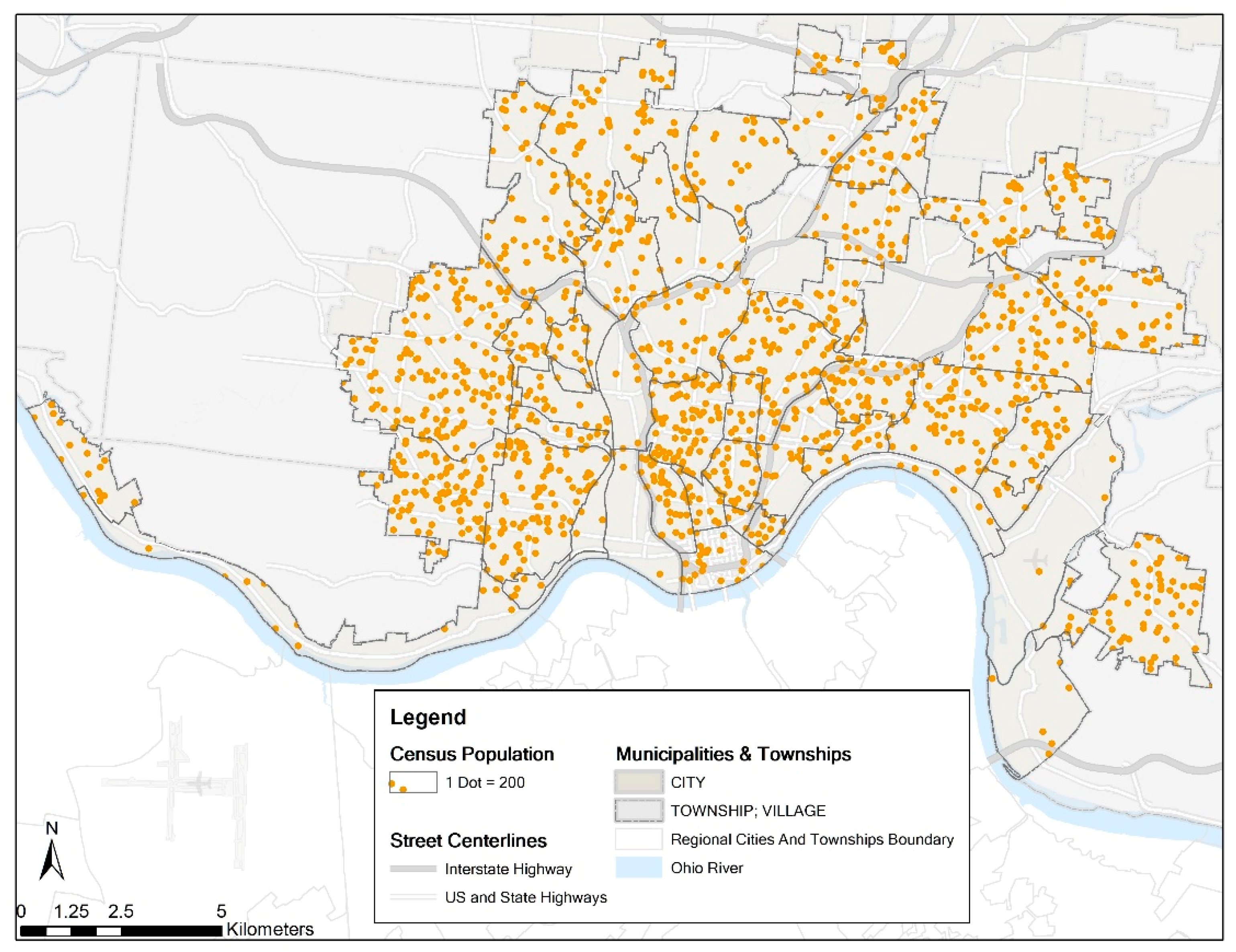
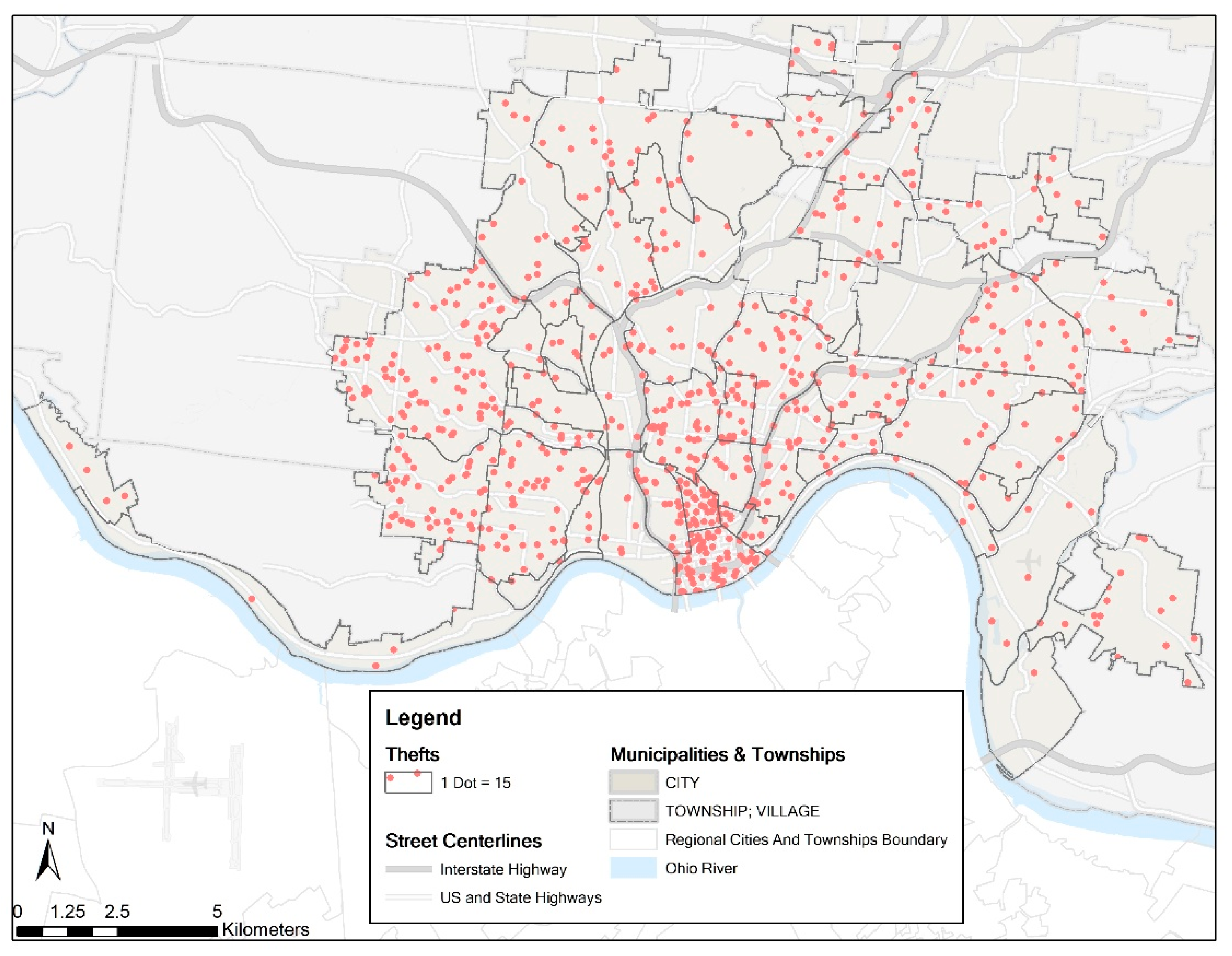
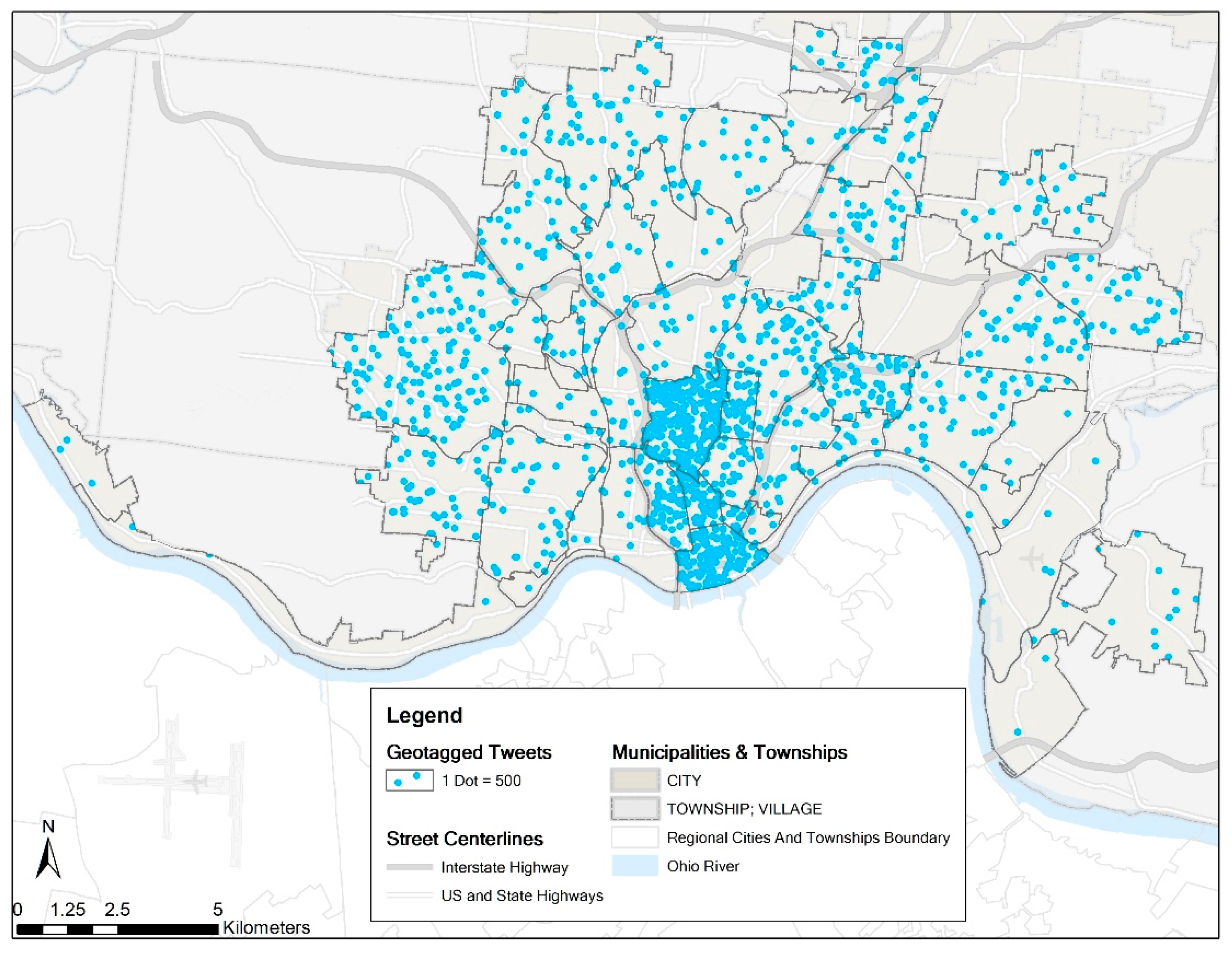
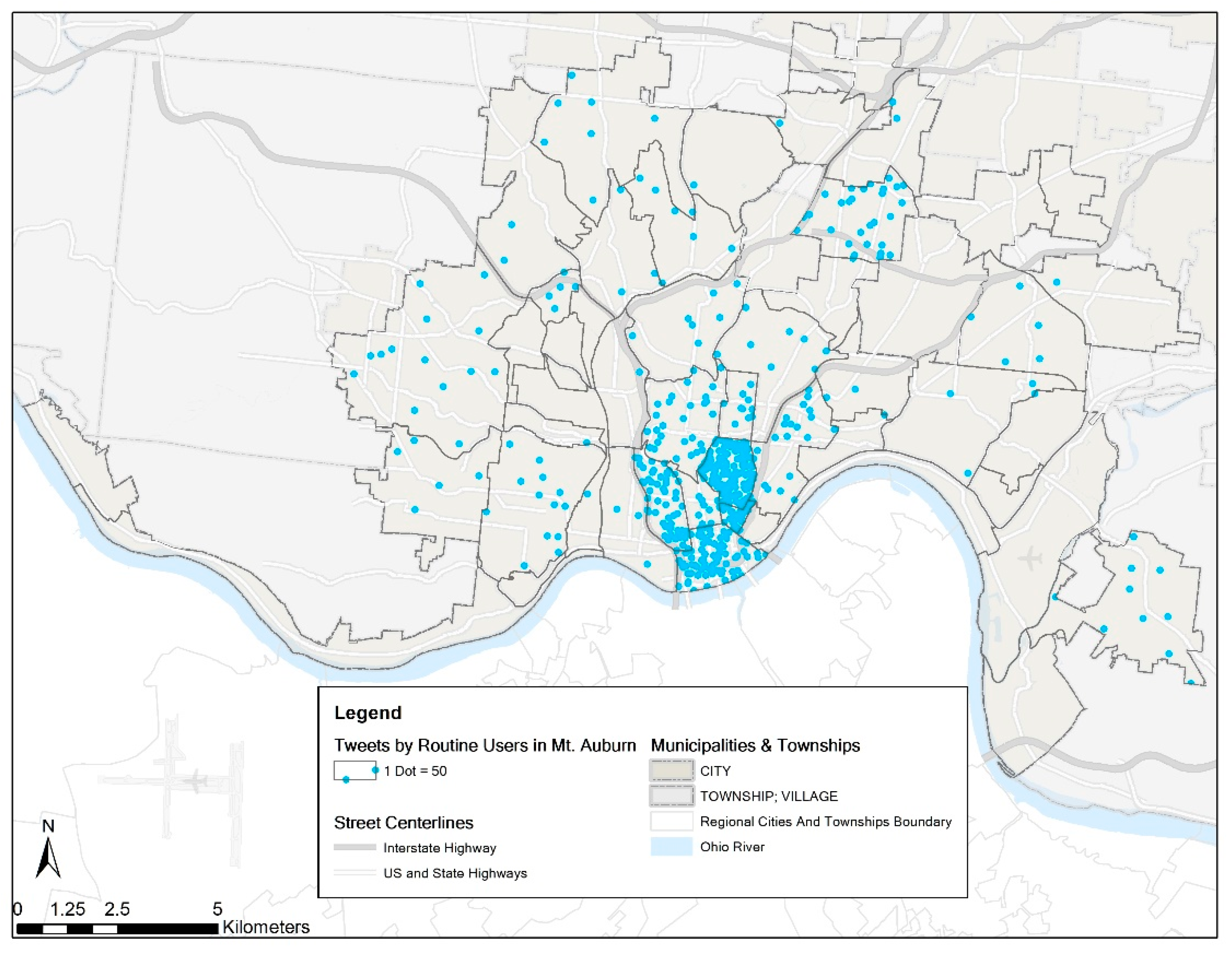
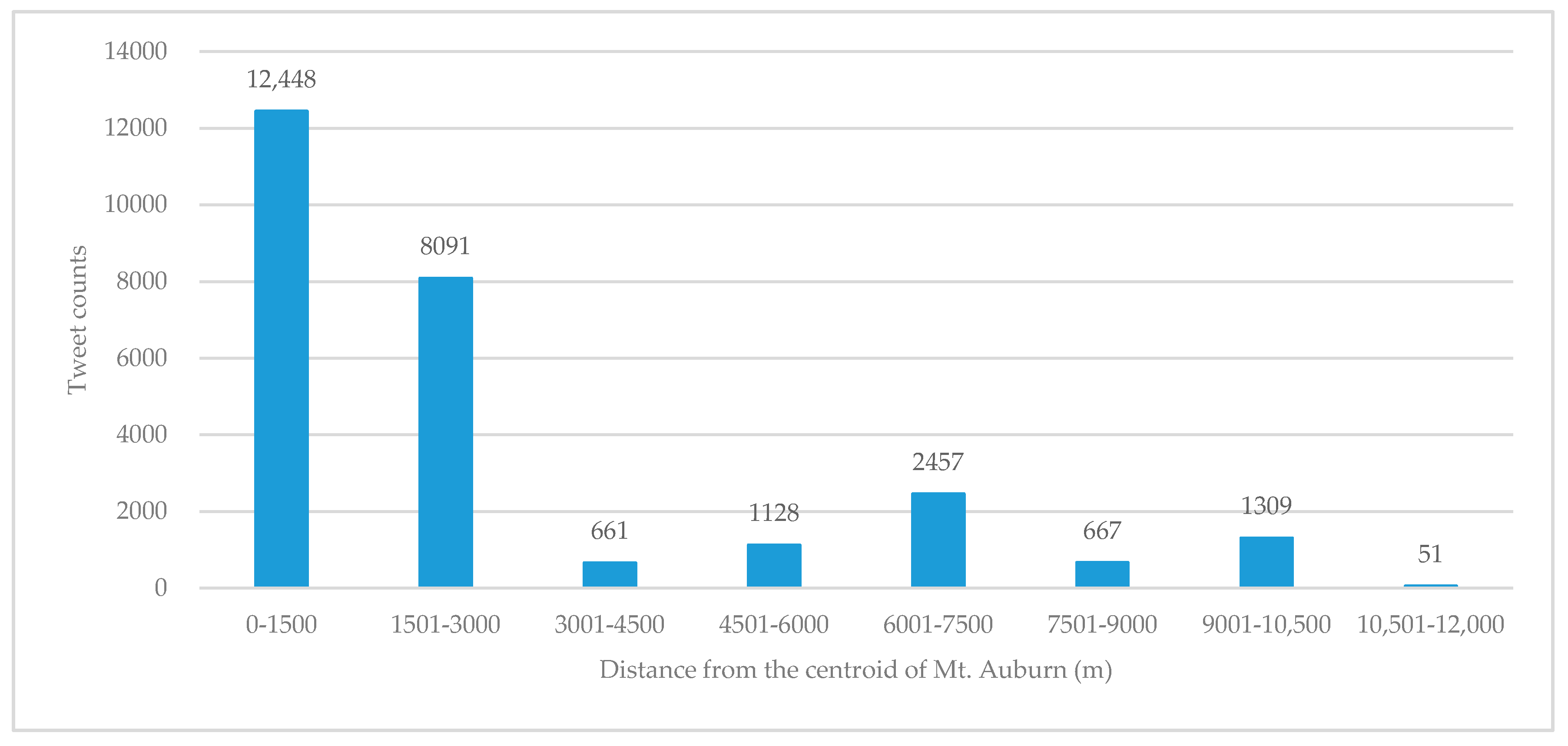
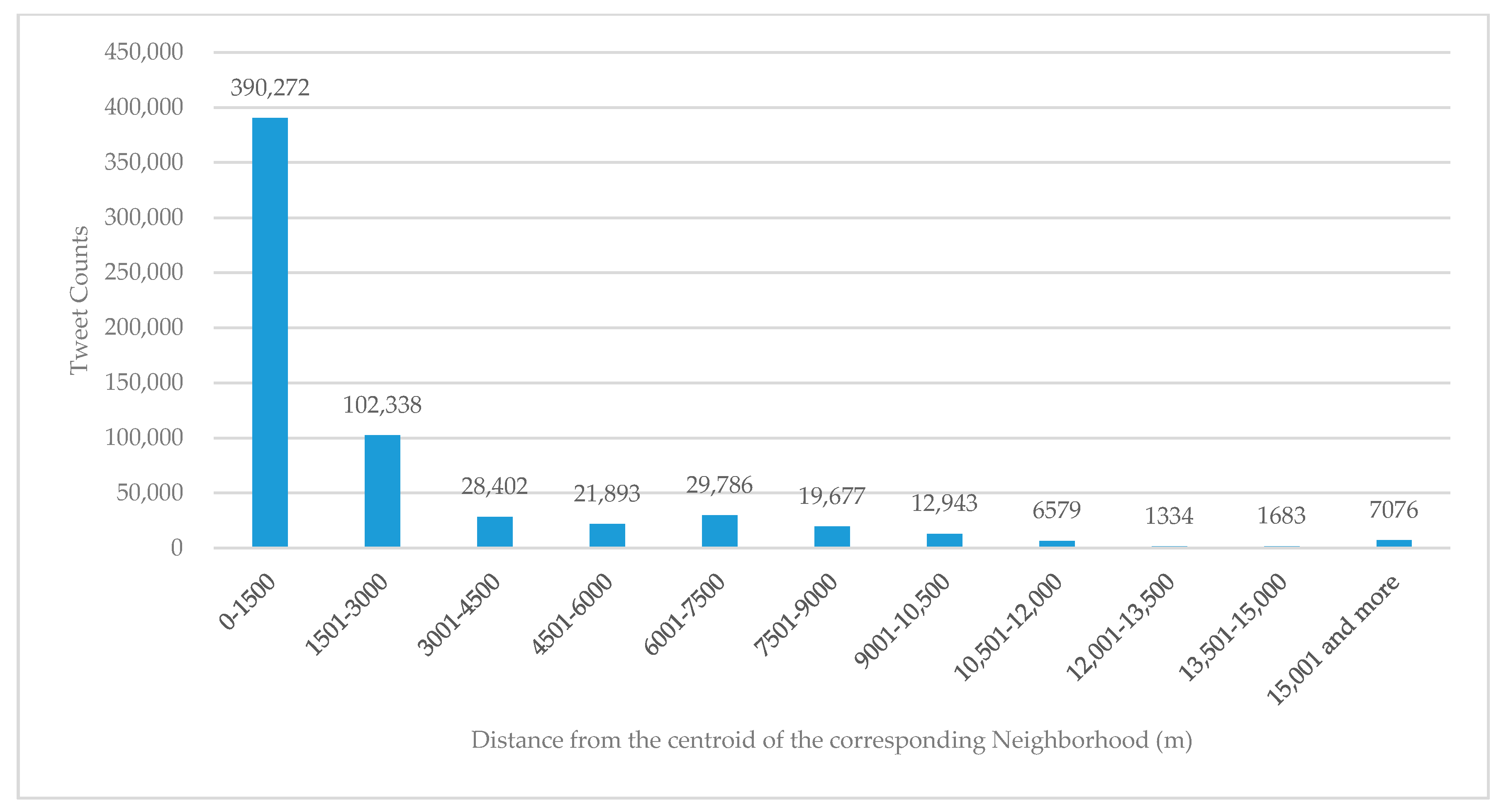
| Variable | Mean | Std. Dev. | Min | Max | |
|---|---|---|---|---|---|
| Dependent Variable | Theft Incidents | 234.840 | 249.107 | 15.000 | 1312.000 |
| Independent Variables | Tweets | 15,568.240 | 22,973.780 | 336.000 | 138,102.000 |
| Tweets (Spatial Lag) | 17,098.210 | 13,043.950 | 1571.500 | 59,720.330 | |
| Census Population | 6127.700 | 5904.898 | 193.000 | 29,858.000 | |
| Census Population (Spatial Lag) | 6450.179 | 3035.563 | 911.500 | 16,433.330 | |
| Control Variables | Poverty Rate | 30.661 | 20.143 | 2.336 | 84.457 |
| Unemployment Rate | 37.796 | 10.114 | 12.175 | 69.075 | |
| Young Population (<18) Rate | 24.295 | 11.074 | 2.971 | 48.989 | |
| Median Household Income | 37,298.220 | 25,510.770 | 0 | 120,055.800 | |
| Housing Rental Rate | 58.277 | 22.263 | 0 | 100.000 | |
| Housing Vacancy Rate | 23.649 | 14.356 | 0 | 69.063 | |
| Ethnic Heterogeneity Index | 0.366 | 0.188 | 0 | 0.774 | |
| Crime Generators/Attractors | 141.840 | 106.863 | 16.000 | 562.000 |
| Dependent Variable: Thefts | Model 1 | Model 2 | Model 3 | Model 4 | Model 5 | Model 6 | ||||||
|---|---|---|---|---|---|---|---|---|---|---|---|---|
| Standardized Coefficient (*10−2) β | p-Value | Standardized Coefficient (*10−2) β | p-Value | Standardized Coefficient (*10−2) β | p-Value | Standardized Coefficient (*10−2) β | p-Value | Standardized Coefficient (*10−2) β | p-Value | Standardized Coefficient (*10−2) β | p-Value | |
| Tweets | 0.059 | 0.008 | 0.032 | 0.172 | 0.073 | 0.002 | 0.057 | 0.048 | ||||
| Tweets (Spatial Lag) | 0.113 | <0.001 | 0.112 | <0.001 | ||||||||
| Census Population | 0.111 | 0.002 | 0.095 | 0.018 | 0.095 | 0.017 | 0.056 | 0.194 | ||||
| Census Population (Spatial Lag) | 0.038 | 0.181 | −0.010 | 0.638 | ||||||||
| Poverty Rate | −0.085 | 0.330 | −0.122 | 0.220 | −0.103 | 0.260 | −0.077 | 0.368 | −0.179 | 0.031 | −0.175 | 0.040 |
| Unemployment Rate | −0.006 | 0.874 | −0.027 | 0.516 | −0.014 | 0.721 | −0.004 | 0.912 | −0.033 | 0.396 | −0.025 | 0.521 |
| Young Population (<18) Rate | −0.053 | 0.112 | 0.006 | 0.885 | −0.033 | 0.433 | −0.061 | 0.090 | 0.071 | 0.087 | 0.051 | 0.298 |
| Median Household Income | −0.057 | 0.416 | −0.081 | 0.276 | −0.070 | 0.338 | −0.061 | 0.377 | −0.115 | 0.084 | −0.108 | 0.113 |
| Housing Rental Rate | 0.107 | 0.023 | 0.096 | 0.081 | 0.099 | 0.035 | 0.101 | 0.031 | 0.056 | 0.141 | 0.065 | 0.084 |
| Housing Vacancy Rate | 0.041 | 0.303 | 0.028 | 0.442 | 0.042 | 0.282 | 0.043 | 0.282 | 0.018 | 0.446 | 0.025 | 0.370 |
| Ethnic Heterogeneity Index | 0.007 | 0.863 | 0.001 | 0.980 | 0.005 | 0.911 | −0.014 | 0.796 | −0.022 | 0.508 | −0.015 | 0.689 |
| Crime Generators/Attractors | 0.206 | <0.001 | 0.269 | <0.001 | 0.202 | <0.001 | 0.215 | <0.001 | 0.257 | <0.001 | 0.218 | <0.001 |
| Constant | - | <0.001 | - | <0.001 | - | <0.001 | - | <0.001 | - | <0.001 | - | <0.001 |
| AIC | 580.033 | 582.697 | 581.345 | 580.335 | 566.890 | 569.310 | ||||||
| BIC | 601.065 | 603.729 | 604.290 | 603.279 | 589.834 | 596.078 | ||||||
| Prob. > chi2 | <0.001 | <0.001 | <0.001 | <0.001 | <0.001 | <0.001 | ||||||
| Global Moran’s I of residuals (p-value) | −0.071 (0.050) | −0.113 (0.021) | −0.081 (0.022) | −0.050 (0.298) | −0.082 (0.060) | −0.073 (0.066) | ||||||
| Spatial pattern of residuals | Dispersed | Dispersed | Dispersed | Random | Random | Random | ||||||
© 2019 by the authors. Licensee MDPI, Basel, Switzerland. This article is an open access article distributed under the terms and conditions of the Creative Commons Attribution (CC BY) license (http://creativecommons.org/licenses/by/4.0/).
Share and Cite
Lan, M.; Liu, L.; Hernandez, A.; Liu, W.; Zhou, H.; Wang, Z. The Spillover Effect of Geotagged Tweets as a Measure of Ambient Population for Theft Crime. Sustainability 2019, 11, 6748. https://doi.org/10.3390/su11236748
Lan M, Liu L, Hernandez A, Liu W, Zhou H, Wang Z. The Spillover Effect of Geotagged Tweets as a Measure of Ambient Population for Theft Crime. Sustainability. 2019; 11(23):6748. https://doi.org/10.3390/su11236748
Chicago/Turabian StyleLan, Minxuan, Lin Liu, Andres Hernandez, Weiyi Liu, Hanlin Zhou, and Zengli Wang. 2019. "The Spillover Effect of Geotagged Tweets as a Measure of Ambient Population for Theft Crime" Sustainability 11, no. 23: 6748. https://doi.org/10.3390/su11236748
APA StyleLan, M., Liu, L., Hernandez, A., Liu, W., Zhou, H., & Wang, Z. (2019). The Spillover Effect of Geotagged Tweets as a Measure of Ambient Population for Theft Crime. Sustainability, 11(23), 6748. https://doi.org/10.3390/su11236748






